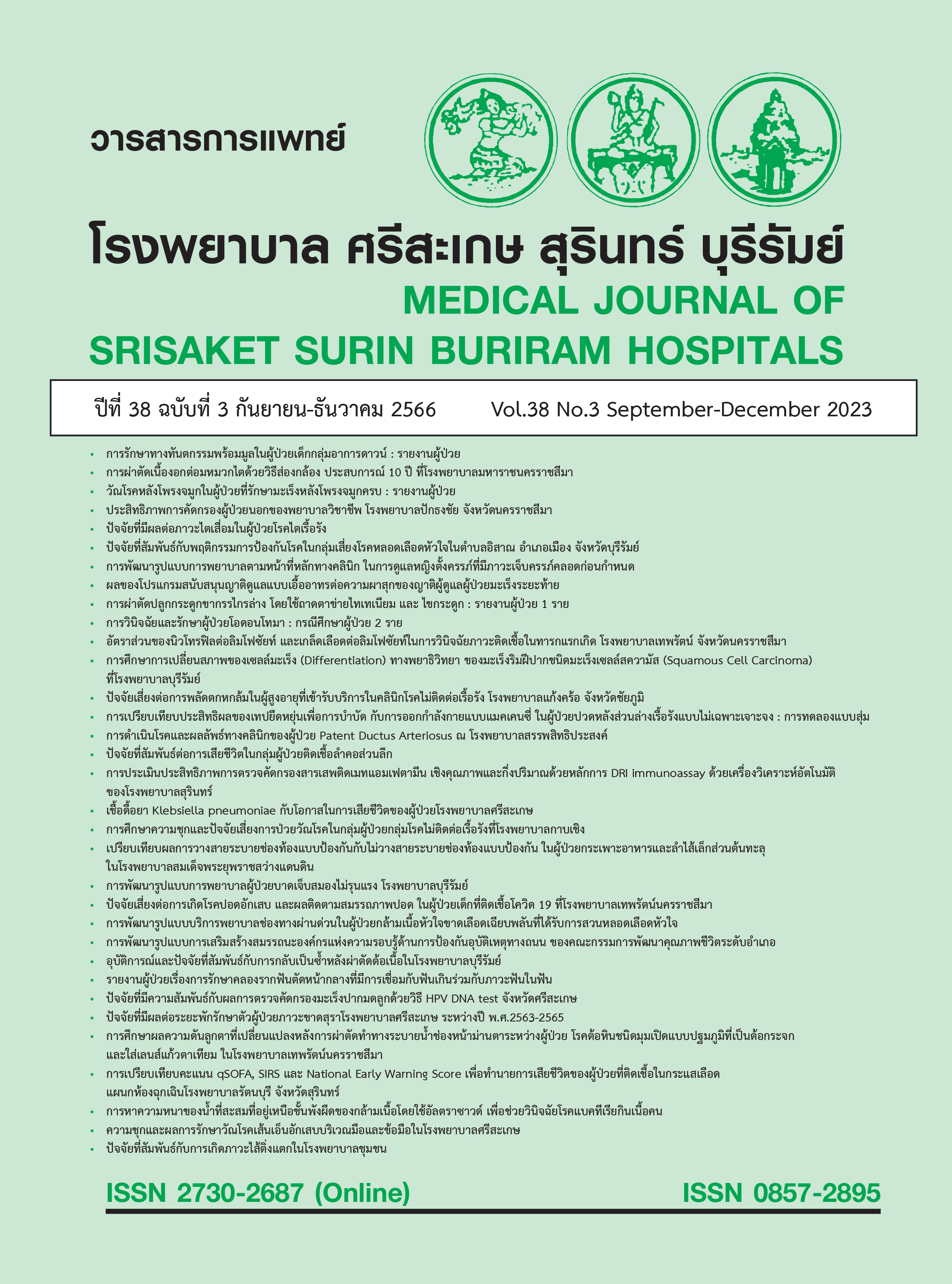การศึกษาการเปลี่ยนสภาพของเซลล์มะเร็ง (Differentiation) ทางพยาธิวิทยา ของมะเร็งริมฝีปากชนิดมะเร็งเซลล์สความัส (Squamous Cell Carcinoma) ที่โรงพยาบาลบุรีรัมย์
Main Article Content
บทคัดย่อ
หลักการและเหตุผล: มะเร็งริมฝีปาก พบได้มากถึงร้อยละ 30 ของมะเร็งช่องปากทั้งหมด ชนิดของมะเร็งริมฝีปากที่พบมากที่สุด คือ มะเร็งเซลล์สความัส (squamous cell carcinoma) พบได้ถึงร้อยละ 90 งานวิจัยนี้ เป็นการศึกษาผลชิ้นเนื้อทางพยาธิวิทยา ของผู้ป่วยมะเร็งริมฝีปากชนิด squamous cell carcinoma ที่เข้ารับการผ่าตัดในโรงพยาบาลบุรีรัมย์ การรู้ความชุกของชิ้นเนื้อมะเร็งความรุนแรงระดับสูง (high-grade) เป็นข้อมูลสำคัญที่ช่วยให้ศัลยแพทย์วางแผนการรักษา และการพยากรณ์โรคได้อย่างมีประสิทธิภาพ
วัตถุประสงค์: เพื่อศึกษาหาความชุกของชิ้นเนื้อที่เป็นมะเร็งระดับ high-grade ตามลักษณะของ tumor differentiation ของมะเร็งริมฝีปากชนิด squamous cell carcinoma
วิธีการศึกษา: การศึกษาเชิงพรรณนา แบบเก็บข้อมูลย้อนหลัง ทบทวนเวชระเบียนผู้ป่วยและผลชิ้นเนื้อมะเร็งริมฝีปากทางพยาธิวิทยาที่ได้รับการวินิจฉัยและผ่าตัดมะเร็งริมฝีปากและส่งตรวจชิ้นเนื้อ ในช่วงวันที่ 1 มกราคม พ.ศ. 2560 ถึง 18 กรกฎาคม พ.ศ. 2566 เก็บข้อมูลด้านอายุ เพศ ตำแหน่งมะเร็ง ผลตรวจทางพยาธิวิทยา ด้านขนาดของมะเร็ง การเปลี่ยนสภาพของเซลล์มะเร็ง การลุกลามเข้าเส้นเลือดหรือท่อน้ำเหลือง และการลุกลาม เข้าไปรอบๆ เส้นประสาท จำแนกผู้ป่วยออกเป็น 3 กลุ่ม ตามลักษณะการเปลี่ยนสภาพของเซลล์มะเร็ง แสดงข้อมูลเป็นจำนวน ร้อยละ ค่าเฉลี่ย และส่วนเบี่ยงเบนมาตรฐาน
ผลการศึกษา: ผู้ป่วยทั้งหมด 111 ราย ผลตรวจชิ้นเนื้อทางพยาธิวิทยาพบลักษณะ well differentiated จำนวน 99 ราย (ร้อยละ 89.2) moderately differentiated จำนวน 11 ราย (ร้อยละ 9.9) และ poorly differentiated จำนวน 1 ราย (ร้อยละ 0.9) พบการลุกลามเข้าเส้นเลือดหรือท่อน้ำเหลือง จำนวน 4 ราย (ร้อยละ 3.6) ใน well differentiated จำนวน 3 ราย (ร้อยละ 3) และmoderately differentiated จำนวน 1 ราย (ร้อยละ 9.1) และพบการลุกลามเข้าไปรอบๆ เส้นประสาทใน poorly differentiated จำนวน 1 ราย (ร้อยละ 100)
moderately differentiated จำนวน 2 ราย (ร้อยละ 18.2) และ well differentiated จำนวน 1 ราย (ร้อยละ 1)
สรุป: ความชุกของชิ้นเนื้อที่เป็นมะเร็งระดับ high-grade ตามลักษณะของ tumor differentiation ของมะเร็งริม ฝีปากชนิด squamous cell carcinoma ในผู้ป่วยโรงพยาบาลบุรีรัมย์คือ ร้อยละ 0.9
Article Details

อนุญาตภายใต้เงื่อนไข Creative Commons Attribution-NonCommercial-NoDerivatives 4.0 International License.
เอกสารอ้างอิง
Saadeh PB, Delacure MD. Chapter 32 Head and neck cancer and salivary gland tumors. In: Hung KC, editor. Grabb & Smith’s Plastic Surgery. 6th. ed. Philadelphia : Lippincott Williams and Wilkins ; 2007 : 333–46.
Salgarelli AC, Sartorelli F, Cangiano A, Pagani R, Collini M. Surgical treatment of lip cancer: our experience with 106 cases. J Oral Maxillofac Surg 2009;67(4):840-5. doi: 10.1016/j.joms.2008.09.020.
Howard A, Agrawal N, Gooi Z. Lip and Oral Cavity Squamous Cell Carcinoma. Hematol Oncol Clin North Am 2021;35(5):895-911. doi: 10.1016/j.hoc.2021.05.003.
de Visscher JG, van der Waal I. Etiology of cancer of the lip. A review. Int J Oral Maxillofac Surg 1998;27(3):199-203. doi: 10.1016/s0901-5027(98)80010-6.
Pereira MC, Oliveira DT, Landman G, Kowalski LP. Histologic subtypes of oral squamous cell carcinoma: prognostic relevance. J Can Dent Assoc 2007;73(4):339-44.PMID: 17484800
Bhargava A, Saigal S, Chalishazar M. Histopathological Grading Systems In Oral Squamous Cell Carcinoma: A Review. J Int Oral Health 2010;2(4):1-10.
Steigen SE, Søland TM, Nginamau ES, Laurvik H, Costea DE, Johannessen AC, et al. Grading of oral squamous cell carcinomas - Intra and interrater agreeability: Simpler is better? J Oral Pathol Med 2020;49(7):630-5. doi: 10.1111/jop.12990.
Zitsch RP 3rd, Park CW, Renner GJ, Rea JL. Outcome analysis for lip carcinoma. Otolaryngol Head Neck Surg 1995;113(5):589-96. doi: 10.1177/019459989511300510.
Chidzonga MM, Mahomva L. Squamous cell carcinoma of the oral cavity, maxillary antrum and lip in a Zimbabwean population: a descriptive epidemiological study. Oral Oncol 2006;42(2):184-9. doi: 10.1016/j.oraloncology.2005.07.011.
Fang KH, Kao HK, Cheng MH, Chang YL, Tsang NM, Huang YC, et al. Histological differentiation of primary oral squamous cell carcinomas in an area of betel quid chewing prevalence. Otolaryngol Head Neck Surg 2009;141(6):743-9. doi: 10.1016/j.otohns.2009.09.012.
Kılıçarslan A, Doğan H. (2018). Clinical and pathological features of squamous cell carcinoma of the lip. Med j islamic world acad sci 2018;26(2):41-5. DOI:10.5505/ias.2018.98623
Lin NC, Hsu JT, Tsai KY. Survival and clinicopathological characteristics of different histological grades of oral cavity squamous cell carcinoma: A single-center retrospective study. PLoS One 2020;15(8):e0238103. doi: 10.1371/journal.pone.0238103.
Sethi S, Lu M, Kapke A, Benninger MS, Worsham MJ. Patient and tumor factors at diagnosis in a multi-ethnic primary head and neck squamous cell carcinoma cohort. J Surg Oncol 2009;99(2):104-8. doi: 10.1002/jso.21190.
Woolgar JA. Histopathological prognosticators in oral and oropharyngeal squamous cell carcinoma. Oral Oncol 2006;42(3):229-39. doi: 10.1016/j.oraloncology.2005.05.008.
Arduino PG, Carrozzo M, Chiecchio A, Broccoletti R, Tirone F, Borra E, et al. Clinical and histopathologic independent prognostic factors in oral squamous cell carcinoma: a retrospective study of 334 cases. J Oral Maxillofac Surg 2008;66(8):1570-9. doi: 10.1016/j.joms.2007.12.024.
d'Alessandro AF, Pinto FR, Lin CS, Kulcsar MA, Cernea CR, Brandão LG, et al. Oral cavity squamous cell carcinoma: factors related to occult lymph node metastasis. Braz J Otorhinolaryngol 2015;81(3):248-54. doi: 10.1016/j.bjorl.2015.03.004.
Binmadi NO, Basile JR. Perineural invasion in oral squamous cell carcinoma: a discussion of significance and review of the literature. Oral Oncol 2011;47(11):1005-10. doi:10.1016/j.oraloncology.2011.08.002.
Jadhav KB, Gupta N. Clinicopathological prognostic implicators of oral squamous cell carcinoma: need to understand and revise. N Am J Med Sci 2013;5(12):671-9. doi: 10.4103/1947-2714.123239.
Padma R, Kalaivani A, Sundaresan S, Sathish P. The relationship between histological differentiation and disease recurrence of primary oral squamous cell carcinoma. J Oral Maxillofac Pathol 2017;21(3):461. doi: 10.4103/jomfp.JOMFP_241_16.
Burusapat C, Jarungroongruangchai W, Charoenpitakchai M. Prognostic factors of cervical node status in head and neck squamous cell carcinoma. World J Surg Oncol 2015;13:51. doi: 10.1186/s12957-015-0460-6.
Rahima B, Shingaki S, Nagata M, Saito C. Prognostic significance of perineural invasion in oral and oropharyngeal carcinoma. Oral Surg Oral Med Oral Pathol Oral Radiol Endod 2004;97(4):423-31. doi: 10.1016/j.tripleo.2003.10.014.
Deepthi G, Shyam NDVN, Kumar GK, Narayen V, Paremala K, Preethi P. Characterization of perineural invasion in different histological grades and variants of oral squamous cell carcinoma. J Oral Maxillofac Pathol 2020;24(1):57-63. doi: 10.4103/jomfp.JOMFP_162_19.
Manjula M, Angadi PV, Priya NK, Hallikerimath S, Kale AD. Assessment of morphological parameters associated with neural invasion in oral squamous cell carcinoma. J Oral Maxillofac Pathol 2019;23(1):157. doi: 10.4103/jomfp.JOMFP_178_18.
Varsha BK, Radhika MB, Makarla S, Kuriakose MA, Kiran GS, Padmalatha GV. Perineural invasion in oral squamous cell carcinoma: Case series and review of literature. J Oral Maxillofac Pathol 2015;19(3):335-41. doi: 10.4103/0973-029X.174630.
Rasheed FS, Abdullah BH. Perineural Invasion in Oral Squamous Cell Carcinoma in Relation to Tumor Depth. J Baghdad Coll Dent 2019;31(2):1–6. DOI: https://doi.org/10.26477/jbcd.v31i2.2616


